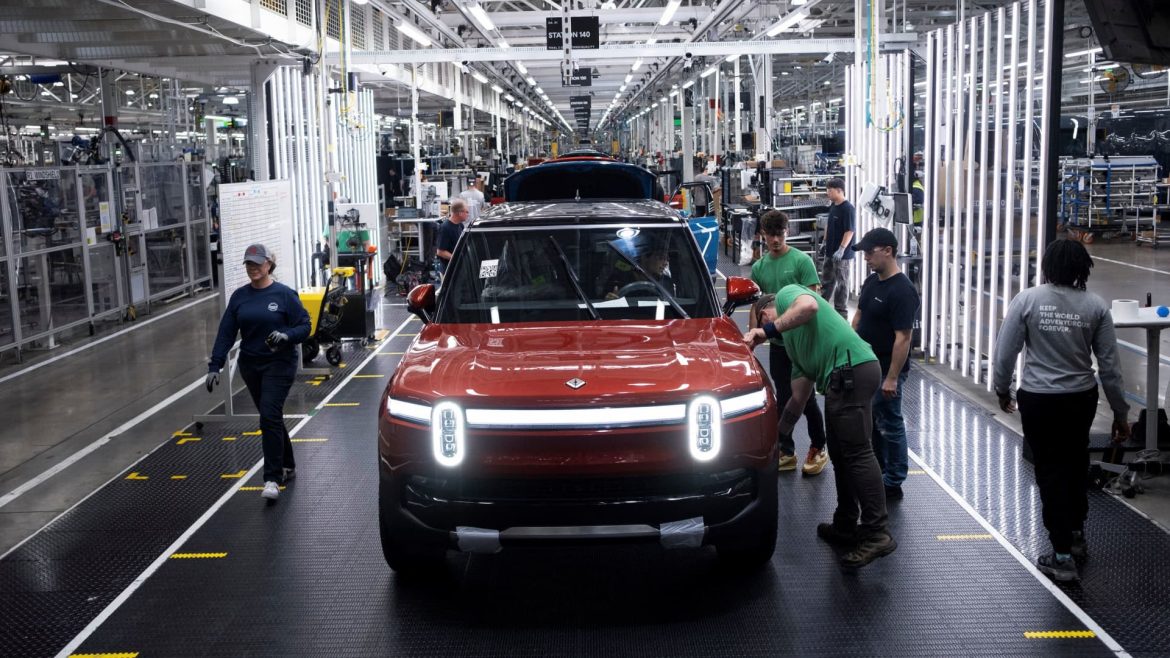Rivian’s Strategic Shift: Navigating Tariff Pressures and Market Expectations
In the ever-evolving landscape of the electric vehicle (EV) industry, Rivian finds itself at a critical juncture. The company has recently announced a significant revision to its 2025 delivery targets and increased expected spending, all amidst growing tariff pressures. This report delves into the implications of these changes, the market’s reaction, and the strategic moves Rivian is making to navigate these challenges.
Revised Delivery Targets and Increased Spending
Rivian’s new guidance for 2025 includes deliveries of between 40,000 and 46,000 units, a notable reduction from previous estimates. This adjustment comes as the company also expects to spend between $1.8 billion and $1.9 billion, highlighting the financial strain it faces. The reduction in delivery targets can be attributed to several factors, including supply chain disruptions, raw material costs, and the looming threat of tariffs on imported vehicles and auto parts.
The Impact of Tariffs
Tariffs, particularly those imposed by the U.S. administration, pose a significant threat to Rivian’s operational and financial outlook. The increase in tariffs on imported batteries, set to take effect in May, is expected to raise production costs substantially. This, in turn, could dampen demand for Rivian’s EVs, further complicating the company’s delivery projections.
Analysts have been quick to react to these developments. Bernstein, for instance, maintained its Underperform rating for Rivian, slashing its price target to $6.10. This represents a potential drop of 47% from Rivian’s last closing price of $11.47. The firm’s forecast underscores the financial challenges Rivian faces, particularly in light of the tariff pressures.
Market Reaction and Analysts’ Perspectives
The market’s reaction to Rivian’s revised guidance has been mixed. While the company’s shares initially rose as much as 7% in extended trading, they later pared gains to trade up about 1%. This volatility reflects the uncertainty surrounding Rivian’s future prospects.
Analysts have been divided in their assessments. Some, like Baird, have adjusted their price targets to align with the average forecast, now sitting at $14.54. Others, such as Bernstein, have been more pessimistic, slashing Rivian’s target to just $6.10. This stark contrast in analyst opinions underscores the complexity of Rivian’s situation and the range of potential outcomes.
Strategic Moves and Future Outlook
Despite the challenges, Rivian is not standing still. The company has announced plans to invest $120 million to bring key parts suppliers near its plant in Illinois. This move is aimed at mitigating supply chain disruptions and ensuring a steady flow of components for its manufacturing operations.
Moreover, Rivian is focusing on cost-cutting measures to enhance its financial health. The company expects to post a modest gross profit in 2025, a positive sign amidst the turmoil. This profit is anticipated to come from slashing raw material and supply chain costs, demonstrating Rivian’s commitment to operational efficiency.
The Road Ahead
As Rivian navigates these turbulent waters, several key factors will shape its future. The resolution of the tariff war, the company’s ability to adapt to supply chain disruptions, and its success in executing cost-cutting measures will all play crucial roles. Additionally, Rivian’s strategic investments in its manufacturing capabilities and supplier relationships will be vital in ensuring long-term sustainability.
Conclusion: A Pivotal Moment
Rivian’s decision to cut its 2025 delivery targets and increase expected spending amidst tariff pressures marks a pivotal moment for the company. While the challenges are substantial, Rivian’s proactive measures and strategic investments offer a glimmer of hope. The coming months will be critical in determining whether Rivian can weather the storm and emerge stronger on the other side. As the EV industry continues to evolve, Rivian’s journey will serve as a testament to the resilience and adaptability required to thrive in a rapidly changing market.


